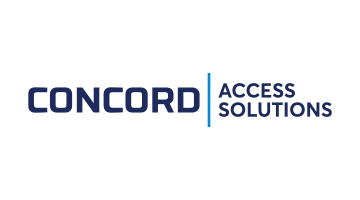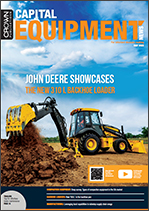 John Deere showcases the new 310 L backhoe loader
John Deere showcases the new 310 L backhoe loader
On the cover: John Deere introduced the 310 L backhoe loader during Grain SA’s NAMPO Harvest Day exhibition in May this year as a smaller, centre pivot version of the sideshift 315 SL, aimed at a different clientele.
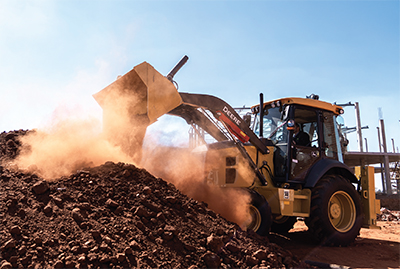 Griffiths Makgate, John Deere Construction & Forestry Sales manager covering Africa and Middle East, explains that, on the 315 SL model backhoe loader, the rear configuration is designed for general construction purposes and infrastructure development where workspace is often limited as it has a sliding backhoe. On the 310 L, the rear stabilisers are not vertical but ‘go wide’, making the machine more suitable to agricultural applications and non-restrictive applications based on the rear stabilisers in the construction.
Griffiths Makgate, John Deere Construction & Forestry Sales manager covering Africa and Middle East, explains that, on the 315 SL model backhoe loader, the rear configuration is designed for general construction purposes and infrastructure development where workspace is often limited as it has a sliding backhoe. On the 310 L, the rear stabilisers are not vertical but ‘go wide’, making the machine more suitable to agricultural applications and non-restrictive applications based on the rear stabilisers in the construction.
“Because we have a strong agricultural platform with a strong dealership channel,” says Makgate, “our potential to sell the 310 L into the agricultural sector is quite huge.” He says the 310 L comes to the fore through a platform of dealers who know the customers in the agricultural sector quite well where there is generally no restriction in terms of workspace. In fact, John Deere dealers countrywide identified the need for a smaller, nimbler centre pivot version of the 315 SL.
“The centre pivot model has been available in the market over the years and the market was sideshift focused so market penetration has always been difficult but, because of the shift in the market, we were able to bring the 310 L to the market because of our strong links with the agriculture, rental, general construction and other market segments that we participate in. Today, the 310 L is gaining popularity among farmers,” says Makgate.
Snap survey: types of compaction equipment in the SA market
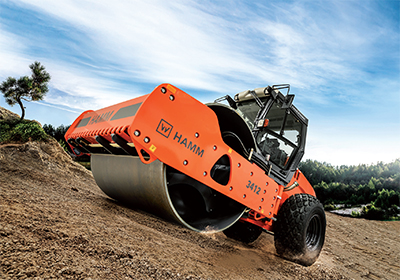 Efficient compaction is vital to construction, road building, earthworks, paving and other applications. This feature sheds light on the types of compaction equipment available in the market, their respective features and new developments in terms of technology to simplify the compaction process and to provide quality compaction where it is needed.
Efficient compaction is vital to construction, road building, earthworks, paving and other applications. This feature sheds light on the types of compaction equipment available in the market, their respective features and new developments in terms of technology to simplify the compaction process and to provide quality compaction where it is needed.
Waylon Kukard, sales manager at Wirtgen Group South Africa, says Hamm offers the biggest roller portfolio in the compaction market, with the range including small ride-on tandem rollers; large tandem rollers; pneumatic tyre rollers and soil compactors.
He says the OEM’s small ride-on tandem rollers, which range from 1,8 t to 4,5 t units, have different configuration options including vibration front and rear (VV); vibration front and oscillation rear (VO); vibration front and tyres rear (VT), and full pneumatic tyre rollers.
The large tandem rollers in the range (7 t – 14 t) feature configuration options including vibration front and rear (VV); vibration front and oscillation rear (VO); vibration front and tyres rear (VT); vibration, split drums front and rear (VV-S); vibration split front and oscillation rear (VO-S), and oscillation front and tyres rear (OT).
Hamm pneumatic tyre rollers, which range from 8 t to 28 t, have flexible ballast weights, as well as single and double-axle brake options.
New ‘BULL’ in the backhoe pen
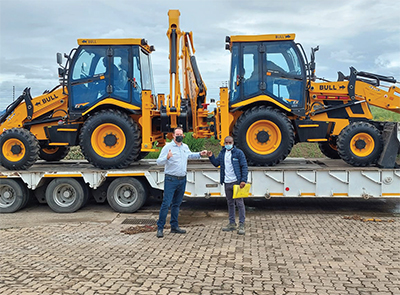 Having received its first batch of BULL backhoe loaders in December last year, Kemach Equipment has sold just over 20 machines thus far. Despite the competitive nature of the backhoe loader market, the company believes it has the ultimate tool to challenge for a 10 – 12% market share.
Having received its first batch of BULL backhoe loaders in December last year, Kemach Equipment has sold just over 20 machines thus far. Despite the competitive nature of the backhoe loader market, the company believes it has the ultimate tool to challenge for a 10 – 12% market share.
As part of its business realignment strategy, Kemach Equipment signed a distributorship agreement for the BULL range of backhoe loaders in July last year. Despite the initial slow uptake, Mark Senyard, national support and marketing manager at Kemach Equipment, has seen a growing interest in the product in recent months.
While the BULL brand has been available in South Africa since 2017 through previous dealers, Senyard says many customers in the mainstream construction and plant hire sectors were not familiar with the brand.
“We initially had a slow take-up as many of our existing customers felt it was an unknown brand in South Africa,” he says. “Having conducted a strong brand awareness campaign and demonstrated the machine range’s capabilities, customers are starting to accept the BULL offering. Feedback from those who have used the machine has been positive.”
Tips for effortless trailer maintenance
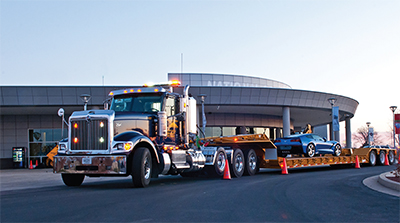 It’s only natural to want an easier solution for efficiency-draining tasks like maintenance. However, as any pro athlete will tell you, advancing to the point where something becomes effortless is rarely easy. It takes commitment and determination, not to mention buy-in from the whole team.
It’s only natural to want an easier solution for efficiency-draining tasks like maintenance. However, as any pro athlete will tell you, advancing to the point where something becomes effortless is rarely easy. It takes commitment and determination, not to mention buy-in from the whole team.
Still, the rewards that come with a well-honed trailer maintenance routine – increased safety, more productivity, longer service life and better ROI – make it a worthwhile goal of any operation. Following here are some tips to help create an effective maintenance routine.
Starting the game with quality equipment gives teams more time to focus on their skills and improve their performance. The same is true for trailer maintenance. Investing in equipment that minimises upkeep requirements from the outset makes it easier to establish a maintenance routine. Look for well-constructed units with quality components such as heavy-duty T-1, 100 000-psi minimum yield steel and premium primer and paint options. These trailers might cost a little more initially but provide long-term dependability that reduces overall maintenance.
Unpacking the risks faced by heavy commercial vehicle operators and goods in transit
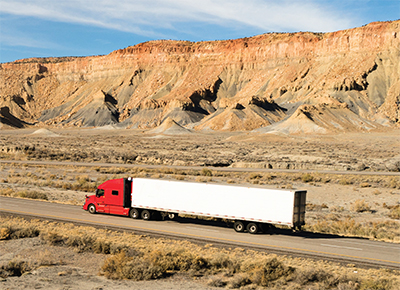 The cost of insuring a heavy commercial vehicle (HCV) fleet faced a massive premium increase in SASRIA cover for loss or damage due to civil commotion, riots, strikes and terrorism. Following a spate of looting and rioting in KwaZulu-Natal (KZN) and Gauteng in July 2021, February 2022 brought increases of over 1 700% as the special risk insurer looks to rebuild capacity after losses totalling R32-billion, spread over 14 000 claims. The massive losses mean that policyholders will face very large increases on certain classes of business to ensure the sustainability of the insurer and its ability to pay claims on this crucial cover again in future.
The cost of insuring a heavy commercial vehicle (HCV) fleet faced a massive premium increase in SASRIA cover for loss or damage due to civil commotion, riots, strikes and terrorism. Following a spate of looting and rioting in KwaZulu-Natal (KZN) and Gauteng in July 2021, February 2022 brought increases of over 1 700% as the special risk insurer looks to rebuild capacity after losses totalling R32-billion, spread over 14 000 claims. The massive losses mean that policyholders will face very large increases on certain classes of business to ensure the sustainability of the insurer and its ability to pay claims on this crucial cover again in future.
HCV operators have been hardest hit with trucks exceeding 3 500 kg attracting a 1 736% increase. In material terms, that means that SASRIA cover for an HCV worth R2-million will increase from R375 per annum to R6 900 per annum for 2022. An HCV insured for R500 000 saw a premium hike from R94 to just over R1 720.
Light commercial vehicles (under 3 500 kg) saw premiums increasing by 1 455%. Extrapolate this across a fleet of vehicles and the financial implications for HCV operators are onerous – where SASRIA cover was previously a relatively insignificant driver of insurance costs for a fleet operator, it is now a major cost, likely to be passed on to the end-user. However, when one considers the risks of the operating environment, and the continued risks for violent protests, riots, looting and even simmering xenophobic tensions, the risks posed to the insurer and the insured are very real and present.
Leveraging local capabilities to sidestep supply chain snags
The COVID-19 pandemic has affected every part of the global supply chain, putting untold pressure on manufacturers. Leveraging its in-house design, manufacture and supply capabilities, complemented by a high local content, vibrating screen specialist Kwatani has successfully navigated the supply chain challenges and minimised the impact of disruptions on operations and lead times.
he COVID-19 pandemic has exposed the fragility and shortcomings of global supply chains. This has been exacerbated by other non-pandemic factors, such as the geopolitical turbulence in Eastern Europe, pushing the entire system to the breaking point and creating one big global logistical nightmare.
Issues such as the ongoing shortages of steel, shipping delays, shipping container shortages and ultimately higher shipping costs are hurting original equipment manufacturers (OEMs) on all dimensions of their businesses. Consequently, end users have had to bear the brunt of record lead times for their mission-critical capital equipment.
While the global supply chain challenges have tested the organisational resilience of the majority of OEMs across the globe, Kwatani has strongly leveraged its in-house capabilities to steer through the turbulent times, says CEO Kim Schoepflin.
Supply chain risks need to be built into construction contracts
Current logistical bottlenecks present high risks for contractors in completing capital projects, for miners and other industries, and they need to protect themselves against penalties
Supply chain disruptions, which emerged as a result of Covid-19 lockdowns in 2020, and were joined by rising inflation towards the end of 2021, have intensified in the first part of 2022. With the war in Ukraine and the Covid-19 shutdown in Shanghai, it looks as if disruptions may worsen.
The other side of logistical disruption and the war in Ukraine is that it is causing a spike in the prices of certain commodities, so mining companies are more anxious than ever to accelerate expansion projects – even as their contractors are battling to secure the necessary inputs.
For example, the shortage of microchips, which are used in a vast range of consumer products, including cell phones and automotive vehicles, stemmed not only from the closure of factories but also rising demand for technology, when more employees had to work from home. Three-quarters of microchip production is located in East Asia, according to the New York Times.





